Complementing the survey results in the previous chapter, this section of the report is based on a different approach to data collection. Rather than asking people about their experiences with news on YouTube, researchers used both computational tools and human coders to examine some of the attributes of the most popular YouTube news channels and the content of the videos they publish.
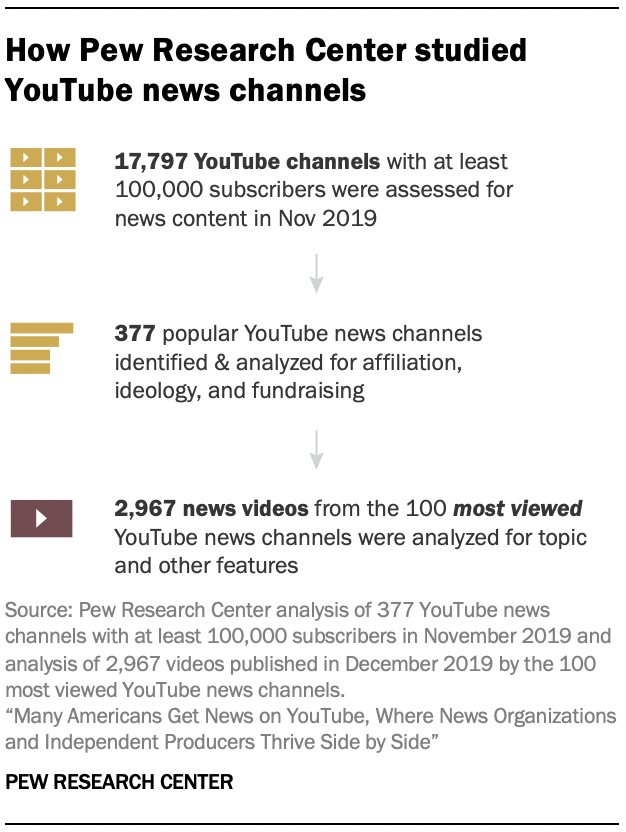
The first part of this analysis looks at 377 YouTube channels that frequently cover news and current affairs and that had at least 100,000 subscribers in November 2019.7 Channels were selected using a recommendation analysis similar to the process used in previous Pew Research Center research on YouTube (see the methodology for more details). These channels are referred to as “popular YouTube news channels” in this report, and were examined for external affiliation, the presence of a host, ideology and other characteristics.
The second part of the analysis looks at the videos published by a subset of those channels in order to get a sense of the type of news actually watched by the largest numbers of YouTube news consumers. To narrow the list of channels to a manageable number for the small group of human coders who watched the videos and categorized them, the analysis includes only the 100 channels with the highest views on their median video published in December 2019. Nearly 3,000 videos (2,967) published by these channels in December 2019 were examined by the coders for the topics and tone contained within them, among other attributes.
The two analyses find that YouTube’s platform is a diverse news environment that provides space for independent news creators to thrive alongside more traditional news organizations, and that the content on these different types of channels varies in important ways. For instance, independent channels are more likely to be centered around a specific personality – often someone who had no public profile before gaining attention on YouTube – and more likely to seek donations directly from viewers. In addition, in December 2019, independent channels were collectively more likely than channels associated with news organizations to mention or focus on conspiracy theories and to take a negative tone toward the main subjects of their videos.
The rest of this chapter explains these and other patterns in more detail.
Examining popular YouTube news channels: News on YouTube comes from a mix of news organizations and independent channels
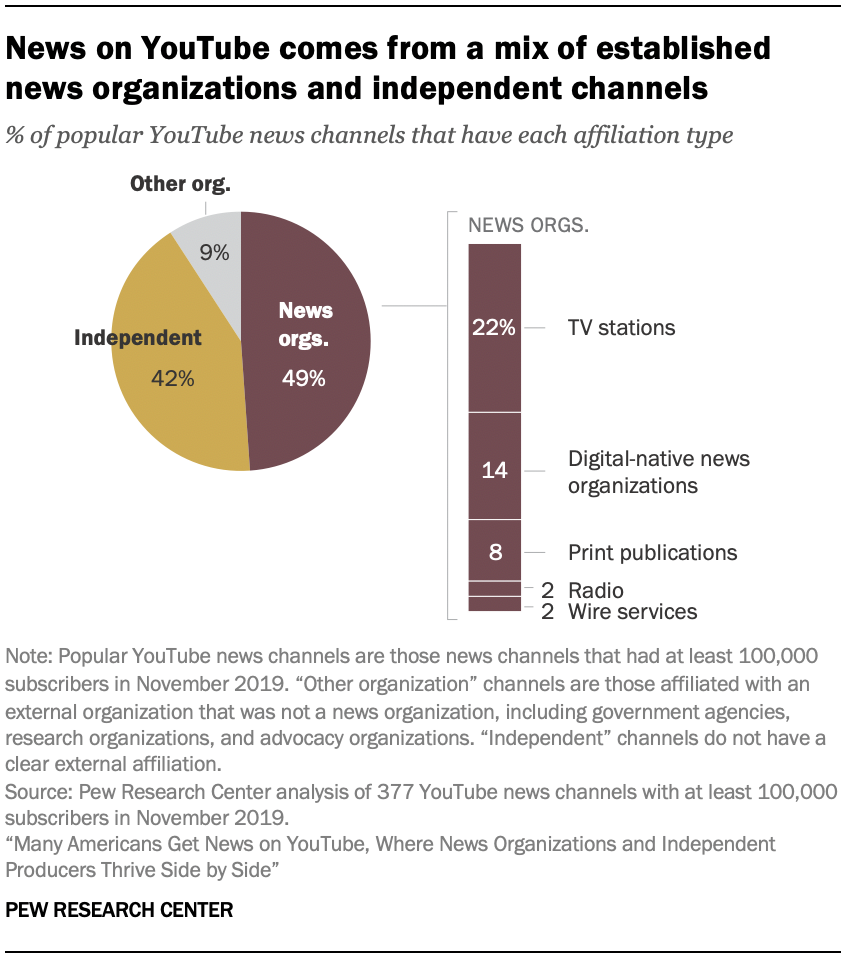
About half (49%) of the 377 most popular YouTube news channels are affiliated with a news organization. For example, these could be the official channel of a news outlet, a channel focused on a particular program or show from that outlet, or a channel featuring associated journalists or anchors.
The largest chunk of these news organization channels (22% of all popular YouTube news channels) are associated with TV stations, including both broadcast and cable outlets and shows they produce. These include national outlets like CNN, Fox News or NBC News, as well as local outlets from across the country, such as CBS News Los Angeles and WXYZ-TV Detroit. This group also includes television shows with news content, such as The Daily Show, The View, and Last Week Tonight, as well as a small number of foreign outlets that produce English-language news, like the BBC.
Channels associated with digital-native news outlets such as BuzzFeed News, The Daily Wire or Vox, as well as those affiliated with print newspapers and magazines (including The New York Times, The Economist and USA Today), also are common among the most popular YouTube news channels (14% of channels are affiliated with digital-native news outlets and 8% are affiliated with print outlets). Fewer popular YouTube news channels are owned by radio stations like NPR or wire services such as The Associated Press.
Popular YouTube news channels that are not affiliated with established news organizations fall into one of two other categories. About one-in-ten channels (9%) are affiliated with other types of organizations, such as government entities or research and advocacy organizations.
But a large share of channels (42%) do not have a clear affiliation with any external entity, referred to throughout this chapter as “independent channels.” In many cases, these are video creators who have established a following based primarily on their YouTube presence, such as Diamond and Silk or The Humanist Report.
These different types of channels seem to adopt different strategies in what kinds of videos they publish and how often they do so. The typical (median) news organization channel produced 33 videos in December 2019, with a median video length of about five minutes. These were often – especially for television outlets – short segments about a specific topic, repackaged from another source. In contrast, the typical independent channel produced far fewer (12) videos, but they were typically much longer, with a median video length of over 12 minutes.
The survey component of this report found that YouTube news consumers are equally likely to get news from independent YouTube channels as they are to get news from news organizations, with 23% saying they often get news from each type of source (see Chapter 1).
About four-in-ten popular YouTube news channels – including most independent channels – are oriented around an individual, often who made their name on YouTube
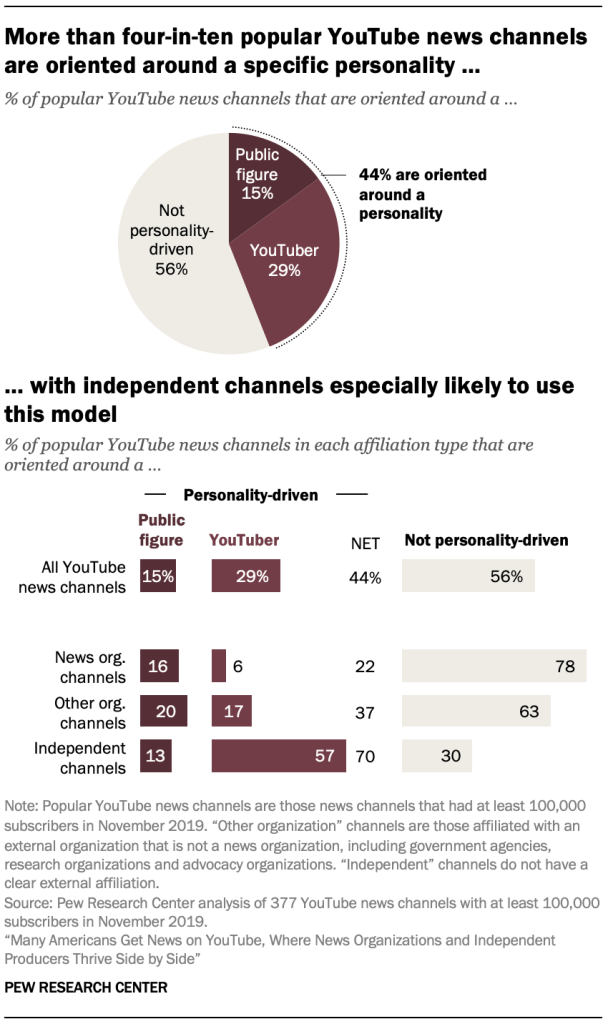
Outside of external affiliation, another way to look at YouTube news channels is to see whether a channel is oriented around an individual – a characteristic especially common to independent channels. In this type of channel, an individual – whether a journalist employed by a news organization or an independent host – puts their personality at the center of the channel and its content. These channels feature the same host, identifiable in all or most of the videos. In the most common video format, the host speaks directly to the camera about their views on a specific issue or event happening in the news. The authenticity of their videos is one of the draws of the channel, much like a blog in the 2000s and 2010s.
Just under half of the most popular YouTube news channels (44%) use this model, referred to here as “personality-driven channels.”
Some of these (15% of all popular YouTube news channels) are hosted by someone who was a public figure before starting a YouTube channel (researchers determined if an individual was a public figure by conducting Google searches on their background before they started a YouTube channel). These include entertainment stars who regularly address the news in their YouTube content, such as Bill Maher or John Oliver, as well as public intellectuals like Sam Harris and independent journalists like Tim Pool.
But social media sites like YouTube are not solely a platform for people who are already public figures. Indeed, YouTube has launched the careers of many influencers, artists and musicians – and discussing news on YouTube can also be an avenue to popularity.
About three-in-ten of the most popular YouTube news channels (29%) are hosted by an individual who built their following through their YouTube channel, a group this study refers to as “YouTubers.” This group is distinct from public figures simply in that any notoriety they have attanined has come after starting a YouTube channel, not before. YouTubers include hosts who talk about a range of issues and current events, like Philip DeFranco, as well as more politically oriented channels, such as Secular Talk or Mark Dice. Importantly, while many of these individuals have built a career off of their work, some have drawn significant negative attention. For instance, some of these channels are hosted by controversial figures, including some run by individuals with ties to racist groups. (Some of these channels, included among the most popular YouTube news channels as of November 2019, have since been banned by YouTube.) And YouTube has often tried to rein in this controversy through video takedowns and demonetization, leading to discrimination lawsuits from YouTubers across the political spectrum.
There is a close link between personality-driven channels – particularly those featuring YouTubers – and independent channels. Indeed, seven-in-ten of the most popular independent YouTube news channels are oriented around a personality, including 57% hosted by YouTubers (compared with just 13% hosted by public figures).
This balance is unique to independent channels. Much smaller proportions of other types of channels are personality-driven. About one-in-five channels affiliated with news organizations (22%) are oriented around an individual, typically the host of a television or radio show like Huckabee or Tom Hartmann. And just 6% of news organization channels are hosted by YouTubers. A somewhat higher share of channels associated with other types of organizations (37%) are oriented around an individual (frequently academics or other prominent researchers), but still, most are not.
Few popular YouTube news channels express an ideological lean on their channel page
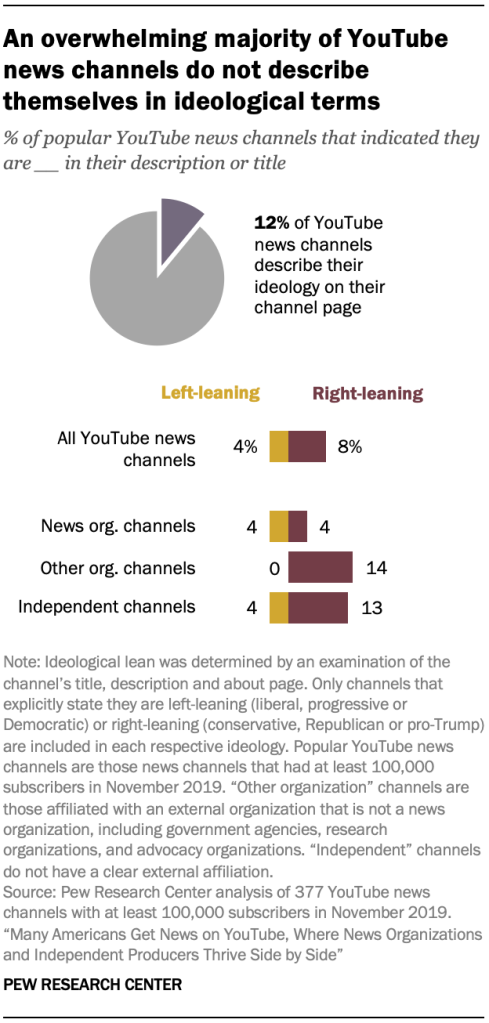
Some observers have cited examples and raised concerns that political discussion on YouTube may be ideological, if not extreme. However, an examination of the channel pages of the most popular YouTube news channels reveals that most do not describe themselves in partisan or ideological terms. In fact, just 12% of popular YouTube news channels claim some kind of partisan or ideological lean in their channel title or description, although this does not necessarily line up with the content of their videos.8
Among those popular YouTube news channels that do claim an ideological label, right-leaning channels are twice as common as left-leaning ones (8% vs. 4% of all channels), although neither group is comprised of more than a handful of channels. Right-leaning channels are defined as those that describe themselves as Republican, conservative or pro-Trump in their channel title or description, while left-leaning channels indicate they are liberal, progressive or Democratic.
Conversely, according to the the survey, YouTube news consumers are more likely to say YouTube videos about politics and social issues lean liberal (32%) rather than conservative (14%), although half say that they are generally moderate (see Chapter 1).
Channels owned by news organizations are the least likely to express an ideological orientation – just 8% of these channels do so, split evenly between those that lean left and right. By contrast, nearly one-in-five independent channels (17%) express a clear partisan lean, with 13% indicating they lean right and 4% leaning left.
A similar proportion of channels affiliated with other organizations (14%) express an ideological orientation, with all of these being right-leaning. Among the 377 most popular YouTube news channels, however, just five fit this description.
About four-in-ten popular YouTube news channels accepted donations
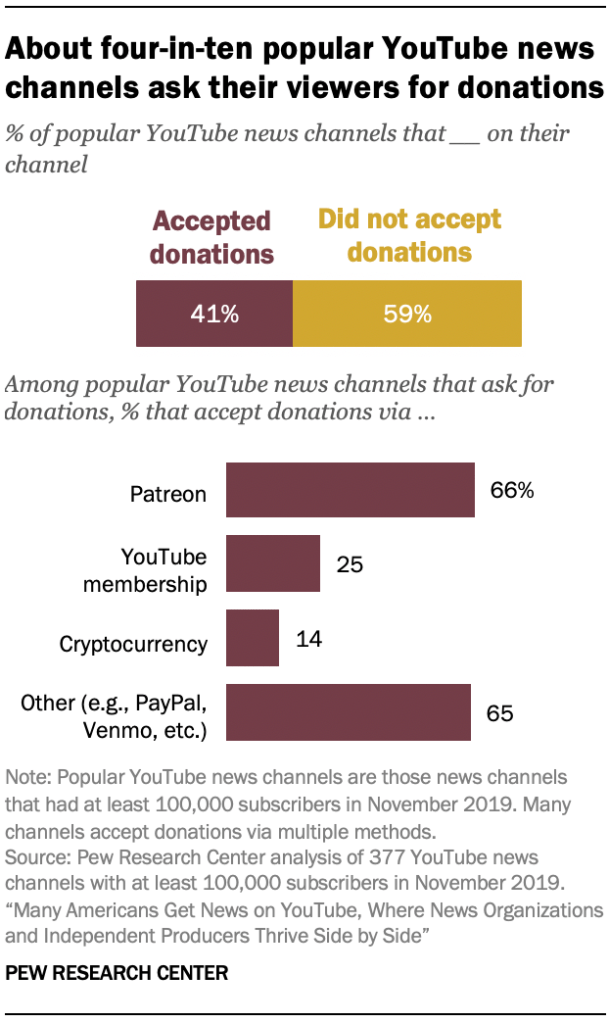
YouTube channel owners have multiple revenue streams available to help offset the costs of running a channel. One income source for popular channels can be revenue sharing from the advertisements that YouTube runs alongside the video itself. But this revenue source is dependent on YouTube, which has adopted policies to restrict access to funding for channels that violate their rules, including briefly excluding ads from channels that made videos about the coronavirus outbreak.
Given the complexities of revenue sharing, many channel owners have adopted alternate income sources, one of which is donations. This analysis finds that 41% of popular YouTube news channels turn to their viewers for donations – especially independent channels.
YouTube channel owners have a number of options for donations, and many channels accept donations through multiple avenues. Patreon is the most common, used by 66% of popular YouTube news channels that accept donations, followed by YouTube’s own donation service (used by 25%). Another 14% of the channels studied that accept donations do so through Bitcoin and other cryptocurrencies. Meanwhile, about two-thirds (65%) of the channels that accept donations use at least one of several other platforms, such as GoFundMe or PayPal. Many services – particularly Patreon and YouTube – feature a subscription option in which users can donate to the channel each month, providing a consistent revenue stream for these channels.
Additionally, roughly three-quarters of popular YouTube news channels that accept donations (74%) provide some kind of benefit to those who donate. These benefits often include access to exclusive videos or digital stickers and badges the donator can use in comments.
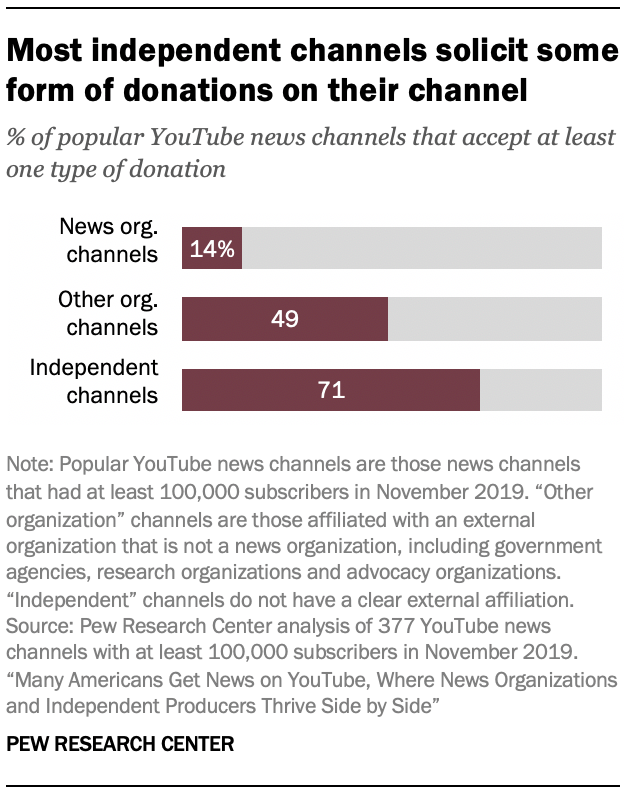
Beyond direct fundraising, many channels also raise funds through merchandise sales. About one-in-five (22%) popular YouTube news channels sell some kind of merchandise (such as coffee mugs or T-shirts) on their YouTube page.
Independent news channels are far more likely than those affiliated with news organizations to accept donations (71% vs. 14%). Channels affiliated with other types of organizations fall in between, with about half (49%) accepting these funds. Similarly, nearly four-in-ten independent channels (37%) sell merchandise, compared with just one-in-ten news organization channels.
Roughly six-in-ten (61%) personality-driven channels accept donations, though this is far more common for channels centered around YouTubers (78%) – personalities who rose to prominence through their YouTube videos – than it is for people who were public figures before they had a YouTube presence (29%). A similar pattern holds for merchandise sales.
YouTubers may be adopting these tools at such high rates as much to build a following as to pull in revenue. For example, member perks like digital badges can appear in user comments, helping promote that membership to other viewers. And the survey component of this study suggests that this may be effective. YouTube news consumers who often get news from YouTubers are far more likely than those who get news from YouTube less frequently to say they have a sense of loyalty to a few YouTube channels (61% vs. 28%).
These practices also may lead to more attention to a channel’s videos. Channels that accept donations or offer privileges to those who donate tend to get far more views than those that do not – and the more views on a video, the more potential ad revenue.
Overwhelming majority of popular YouTube news channels connect with their audiences on multiple platforms
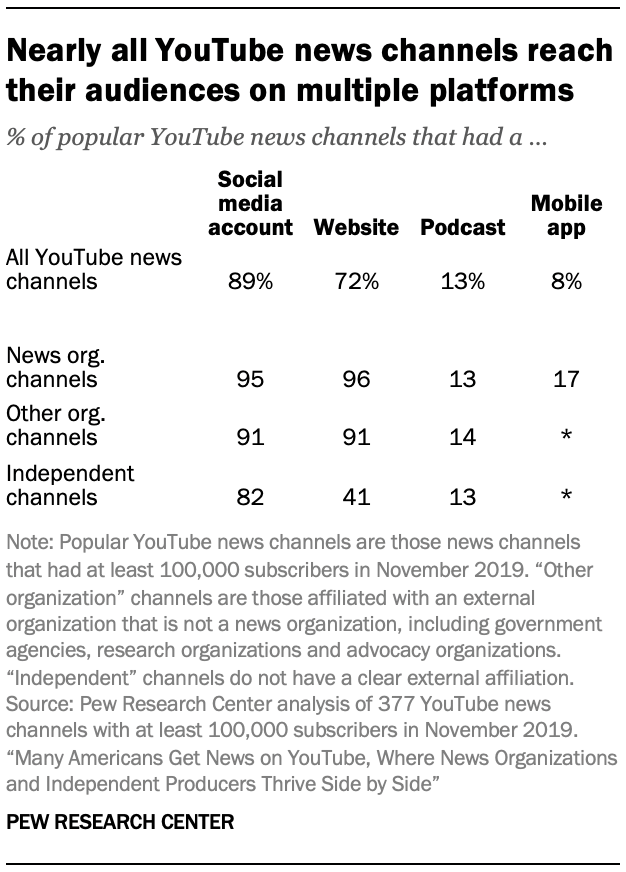
Most channels use multiple avenues to reach potential audiences outside of YouTube. While YouTube news channels also can be discovered through the YouTube recommendation engine or search, those tools are outside the control of the channel creator and do not extend beyond the platform.
To determine whether a channel used these external tools, researchers looked for any social media or other links on that channel’s YouTube page. About nine-in-ten (89%) popular YouTube news channels use at least one other social media platform. Most have a Twitter (84%) or Facebook (76%) account, and about half are on Instagram (52%). A majority (72%) also have a website, while 13% have an accompanying podcast and 8% have a mobile app. Only 6% do not have a presence on any other platform.
Examining videos from the most viewed YouTube news channels: Videos about Trump stood out as especially popular in December 2019
To better understand what kind of news was being covered by news channels on YouTube, researchers further examined 2,967 videos from December 2019, all published during the month by the top 100 of the 377 channels studied and ranked by how many views their typical (median) video received.
Of the 377 news channels included in this study that had at least 100,000 subscribers as of December 2019, 89% posted at least one video in December 2019. From this subset of channels, researchers excluded local news channels and then selected the top 100 channels based on how many views their typical (median) video received that month. Through this process, researchers arrived at a selection of news channels that produce videos that pertain to national or international current events and typically receive a substantial number of views.
Researchers then examined a sample of each channel’s videos from December 2019. With the exception of a handful of extremely prolific channels that produced too many videos to examine in their entirety, this sampling process included most or all of the videos that each channel produced during the month. Altogether, 3,626 videos were examined and then subsequently weighted to be representative of the full collection of videos. Nearly one-in-five of these videos (18%) were not about news or current affairs and were excluded from this analysis, resulting in a final sample of 2,967 videos. The first 10 minutes of each video (or, if the video was shorter than 10 minutes, the entire video) in this final sample was watched by a human researcher and coded for a range of characteristics, including its primary topic, the person or group it focused on, its tone, the number of views it received in its first week and the sources it cited.
This analysis finds that roughly a third of videos from the most viewed YouTube news channels in December 2019 (36%) were primarily about President Trump’s impeachment, while 31% pertained to a range of domestic policy issues such as gun control, abortion or immigration. Other topics included the 2020 election (12%), international affairs (9%), criticism of corporations such as big tech (2%), the news media (2%) and conspiracy theories like QAnon (2%).
Not only were videos about Trump’s impeachment especially common during this period, but they also averaged nearly twice as many views as videos about domestic issues (245,000 vs. 128,000), the second most common topic. The only topic that generated greater viewership was President Trump himself, outside the context of his impeachment. Even though just 3% of the news videos were about Trump and his administration generally (not specifically impeachment), these videos averaged 257,000 views.
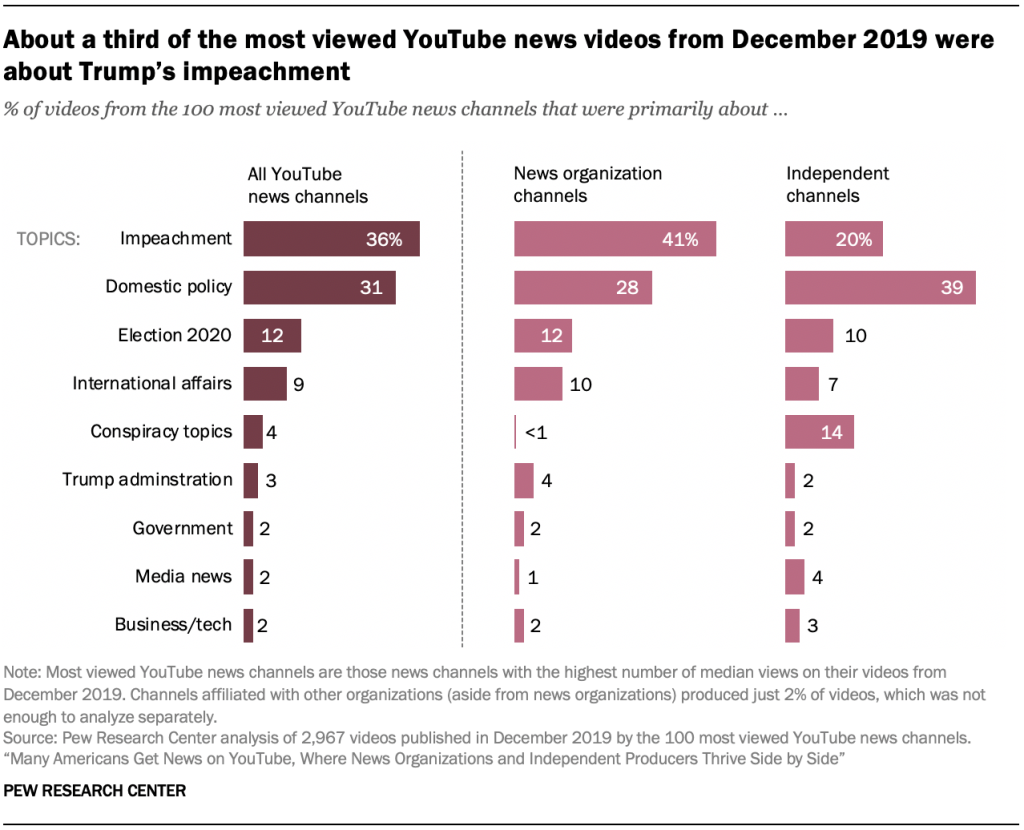
Collectively, channels associated with news organizations tended to produce more videos on the impeachment inquiry, while independent channels concentrated more on domestic issues. About four-in-ten (41%) of videos produced by news organizations primarily covered the impeachment inquiry, about double the proportion produced on this topic by independent channels (20%).9 In contrast, nearly four-in-ten videos produced by independent YouTube news channels (39%) covered domestic policy issues, while a smaller portion of the videos produced by news organizations (28%) did so.
Although videos were analyzed for their primary topic, certain storylines cut across a broad range of issues and came up regularly even in videos that were primarily about other topics. In addition to assessing each video’s main topic, the study also looked at whether a video made any mention at all of two topics that were uniquely prominent during the study period: Trump’s impeachment and the 2020 election. Nearly half of the videos (47%) mentioned the impeachment inquiry and about a quarter (26%) mentioned the 2020 election at least in passing, even if it was not the main topic of the video.
Videos about conspiracy theories almost entirely concentrated among independent channels
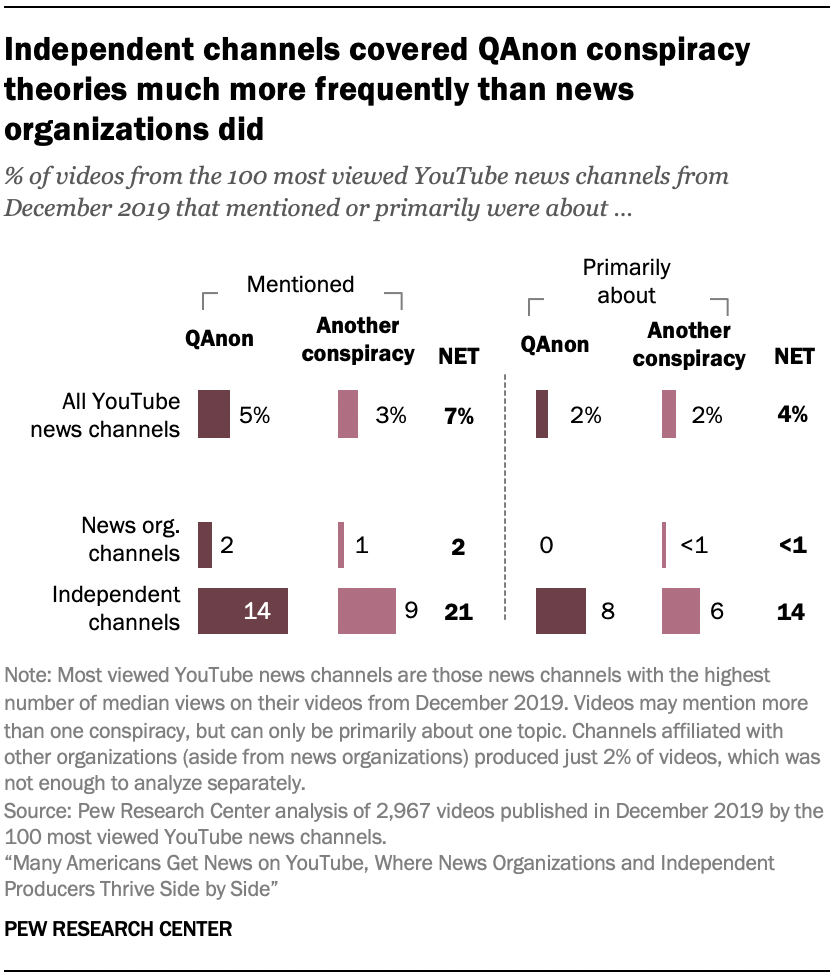
Researchers examined whether videos produced by the 100 most viewed YouTube news channels in December 2019 were primarily about – or at least mentioned – a set of specific conspiracy theories that were prominent in the news media in late 2019, particularly QAnon/deep state conspiracy theories, theories related to Jeffrey Epstein and anti-vaccine theories.10
The analysis found that 7% of the videos mentioned at least one of these conspiracy theories at all, and 4% were primarily about a conspiracy theory. QAnon was the most common conspiracy theory discussed. It was mentioned in 5% of the videos and was the main topic of 2%.
On some types of channels, however, conspiracy theories were mentioned much more regularly. Fewer than 1% of the videos produced by channels that are affiliated with a news organization were about a conspiracy theory, and just 2% of these channels’ videos mentioned any of these theories at all. By contrast, 14% of the videos that were produced by independent channels – those not affiliated with any larger organization – were dedicated to covering conspiracy theories, and roughly one-in-five (21%) of their videos mentioned a conspiracy theory at least briefly. In other words, coverage of conspiracy theories was almost entirely concentrated among videos from independent channels, and virtually absent in videos produced by channels affiliated with news organizations.
The same pattern holds for videos specifically covering the set of conspiracy theories known as QAnon. These theories were mentioned in 14% of videos published by independent channels, compared with 2% of those from news organization channels, and was the primary topic in 8% of videos from independent channels and fewer than 1% of news organizations’ videos.
Roughly a quarter of YouTube news videos focused on Trump; these videos tended to be more popular
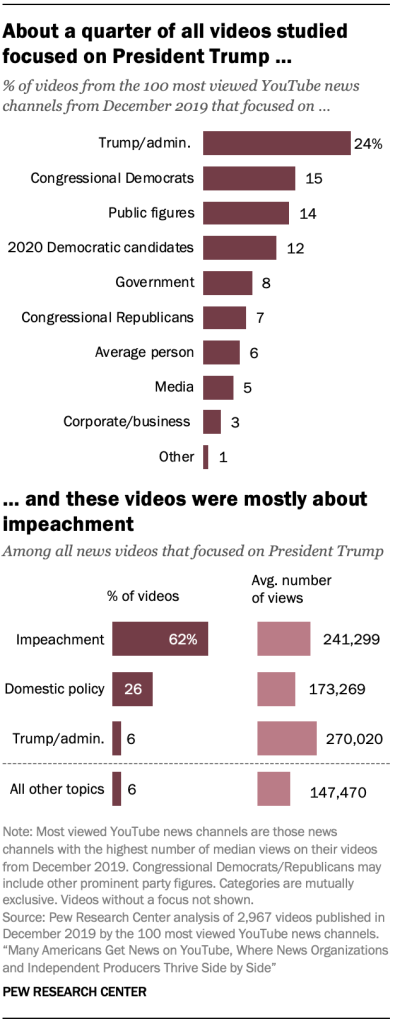
In addition to categorizing a news video’s primary topic, researchers also noted whether a video focused on a specific entity, organization or person (the primary character in the video). Conceptually, a video’s focus is distinct from its topic. For example, while videos that were about Trump’s impeachment often focused on Trump himself, some focused on other figures involved in the impeachment proceedings. Similarly, many videos that focused on Trump were about the impeachment proceedings, but others focused on the president in the context of his administration more generally, domestic issues, and other topics.
Nearly all of the videos examined (95%) had a clear focus, and the most common focus was President Trump. About a quarter (24%) of all videos published in December 2019 by the 100 most viewed YouTube news channels focused on Trump. Smaller shares focused on other figures, like non-political public figures (14%), Democratic presidential candidates (12%) and Democratic members of Congress (15%).
Videos that focused on Trump were notably more popular than those that focused on other people or organizations, or none at all. Trump-focused videos received over 220,000 views, on average, compared with an average of 157,000 views among all other videos. While most of these videos were topically related to Trump’s impeachment, videos that were about Trump in other contexts also received high numbers of views. Of the videos that focused on Trump, 62% were related to his impeachment, and these videos averaged about 241,000 views. However, 6% were about other aspects of Trump or his administration, and these received even more views (roughly 270,000, on average).
Much of the focus on Trump appears to have been driven by news organizations, rather than independent channels. Collectively, news organizations focused on Trump in 28% of their videos – about twice the rate of independent channels, who focused on Trump in just 12% of their videos overall.
Negative YouTube news videos were more common than positive ones and received more views, but most were neither negative nor positive
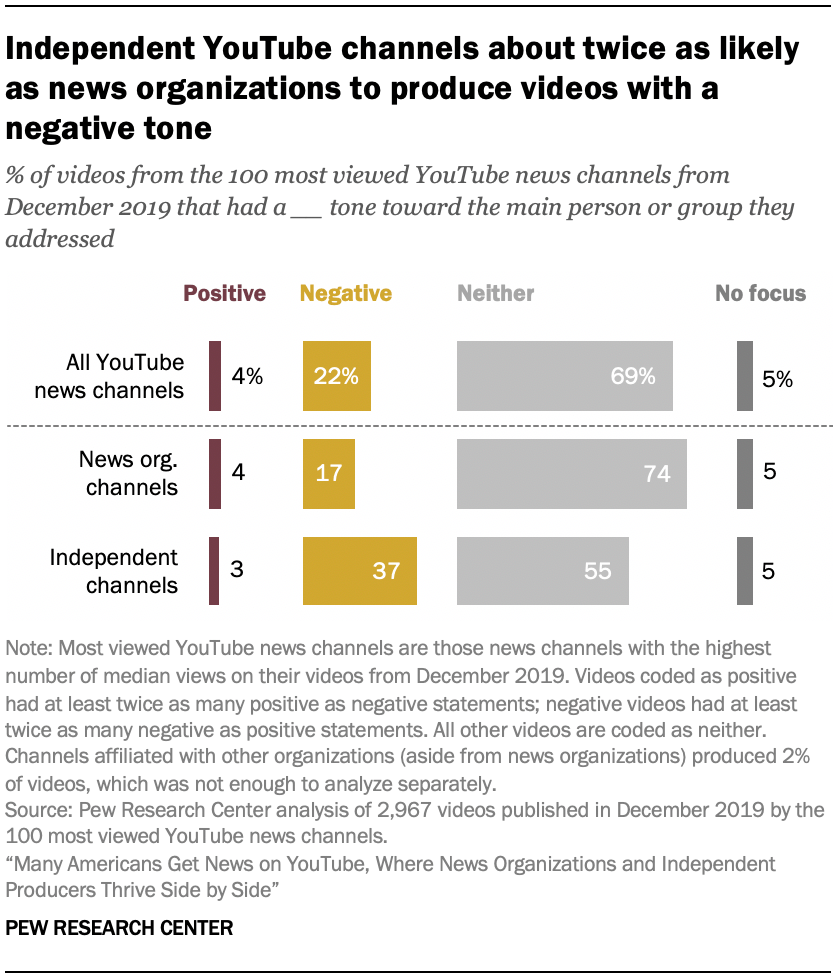
While watching the videos from the 100 most viewed YouTube news channels, researchers also assessed whether each video took a decidedly negative or positive tone toward the person or group it primarily discussed. Videos were considered to have a negative tone if at least twice as many negative statements as positive ones were made about the primary person or group being discussed during the video’s first 10 minutes.11 Similarly, when statements about a video’s primary character were predominantly positive (at least 66% of all mentions), the video was determined to be positive. All other videos were coded as neither positive nor negative (sometimes referred to as “mixed”).
Most of the news videos published by these channels were neither positive nor negative – 69% were either mixed in their tone or took a neutral stance toward the main person or group they discussed. But negative videos still outnumbered positive videos by about five-to-one. Roughly one-in-five (22%) videos took a negative tone toward their main subject, compared with just 4% that had a positive tone. An additional 5% of videos had no focus at all.
Independent channels were more than twice as likely to publish negative videos: 37% of the videos produced by independent channels took a negative tone toward their primary focus, compared with just 17% of the videos that were produced by channels affiliated with news organizations. In contrast, videos from both types of channels rarely had a positive tone.
Negativity also seemed to drive viewership – or, on the other side of the coin, positivity was less effective at capturing an audience’s attention. Videos that were predominantly negative in tone received an average of 184,000 views, somewhat higher than videos that had a mixed or neutral tone, which averaged 172,000 views. On the other hand, videos with a positive tone received notably fewer views, with 117,000, on average. This pattern was reflected in videos that were produced by both types of channels – news organizations and independent channels alike.
YouTube news videos included the news media as source more than any other source type
These videos cited a wide variety of sources in their reporting, with media the most commonly cited source type (only external media citations were included; for example, a video produced by NBC and citing another NBC clip or statements of their own reporters were not counted, but if NBC included a clip from CBS it would be). About half of the videos studied from the 100 most viewed YouTube news channels in December 2019 cited the media (51%), showing that it is common for YouTube news videos to rely on previously reported material.
YouTube news videos also commonly cited prominent political figures (42%). Among political figures, Republicans were cited in slightly more videos than Democrats (28% vs. 21%), while a smaller portion of videos cited nonpartisan government entities (15%). Some videos also cited experts (11%), social media posts (7%), average people (7%), public figures (6%) or polls (6%).
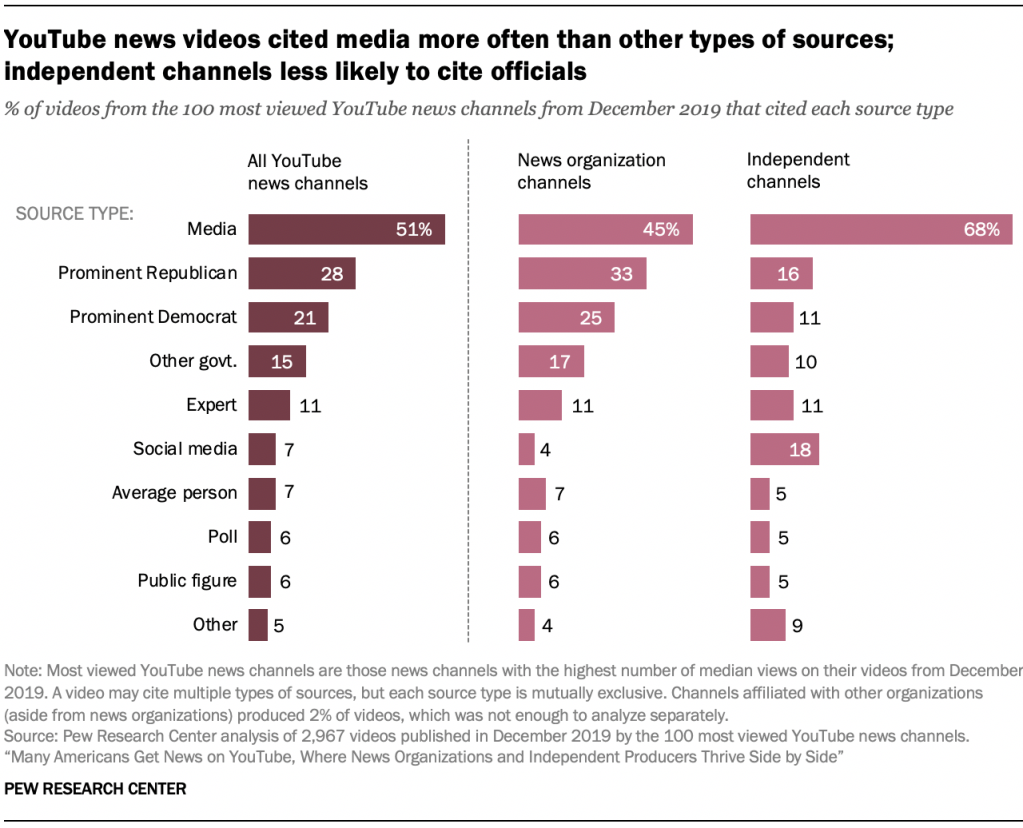
Channels associated with news organizations and those that are independent displayed different tendencies when citing sources. Roughly two-thirds (68%) of videos from independent channels cited media, compared with fewer than half (45%) of videos from news organizations. Videos from independent channels were also considerably more likely than those from news organizations to cite social media sources (18% vs. 4%).
With their tendency to turn to media, and with generally fewer production capabilities, independent channels were less likely to cite elected officials than news organization channels. Videos produced by independent channels were about half as likely to cite Republicans, including President Trump and members of Congress. Just 16% of videos from independent channels did so, compared with a third (33%) of videos produced by news organizations. There was a similar pattern for citing Democrats, including members of Congress and presidential candidates, although these source types were cited less frequently overall (25% of videos from news organizations vs. 11% of videos from independent channels).




